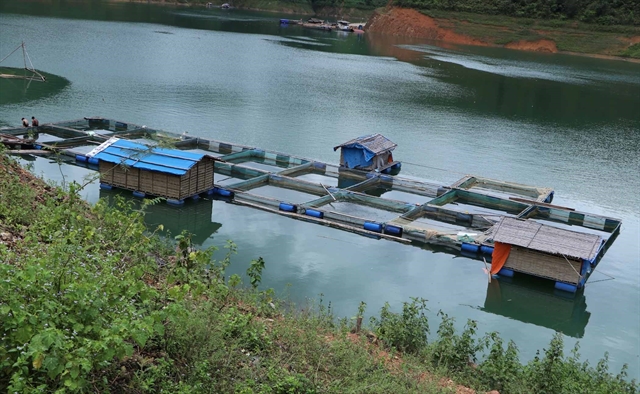 Society
Society


|
| Local farmers in Tà Mít Commune in the northern mountainous province of Lai Châu harvest catfish from floating cages on the Huội Quảng-Bản Chát Hydropower Plant reservoir. — VNA/VNS Photo Quý Trung |
LAI CHÂU — A fish farm floating on a hydropower reservoir has created a stable means of income for people living in the mountainous and remote areas of Lai Châu Province.
In Tân Uyên District, locals have taken advantage of the vast expanse of water in the Huội Quảng-Bản Chát Hydropower Plant reservoir to set up floating cages to farm fish instead of rice.
There are 147 fish cages producing about a tonne of fish each per year, mostly located in Tà Mít Commune.
Lê Thanh Huy, vice chairman of Tân Uyên District’s People’s Committee, said the district had been encouraging to farm fish since 2017, and offered financial support of more than VNĐ3.2 billion ($137,510) to 31 households.
The floating cages have helped improve the lives of local farmers whose crops were submerged by the reservoir.
On average, each household can earn VNĐ100 million ($4,290) per year, helping in the effort to eradicate poverty in the area.
Tà Mít is a remote and disadvantaged commune in Tân Uyên District which is home to about 1,500 people.
Most of them belong to ethnic minority groups, mainly the Thái.
After the reservoir was filled, most of the cultivation area was submerged.
The commune People’s Committee decided to make use of the deep lake to raise fish, mostly catfish, carp, goby and tilapia. In 2018, the provincial People’s Committee allocated more than VNĐ1.5 billion ($64,450) to help developing the commune’s aqua-farming industry.
The first 11 households received financial support to release 55 fish cages.
The committee worked with Sông Thiên Đức JSC to launch a programme to transfer fish farming technology, held training courses to provide farmers with technical know-how and organised field trips to Quỳnh Nhai District in northern Sơn La Province, where fish farming has been successfully implemented.
After two years of farming, a co-operative has been set up with the participation of tens of households.
Tòng Văn Cha, a farmer from Nậm Khăn Village in Tà Mít Commune, said he owned six fish cages that earned him a profit of VNĐ30-35 million ($1,289-1,504) per cage.
“This year, I’ve invested in six cages and received support of VNĐ10 million ($429) per cage from the People’s Committee. Fish farming is more profitable than other forms of agricultural production and my family’s life has much improved,” he said.
Lò Văn Tập, chairman of the People’s Committee, said there were roughly 10,700sq.m of aquaculture in the commune.
Last year, the output of the reservoir was more than 120 tonnes, earning more than VNĐ8 billion ($343,780) for local farmers.
However, Tập said the fish farm still faced difficulties due to unstable output. Most people didn’t know how to build a brand for their products and just sold fish at local markets and restaurants.
He said a favourable policy to attract enterprises to sign contracts to buy fish from farmers was urgent.
Tân Uyên District has continued to encourage households to expand their fish farms on the reservoir. A plan for aquaculture development towards 2030 is also in the making.
The district will create more favourable conditions for enterprises to invest in this field, including reducing land use fees and simplifying applications for operational licences. — VNS

|
| Floating fish farm. — VNA/VNS Photo Quý Trung |




